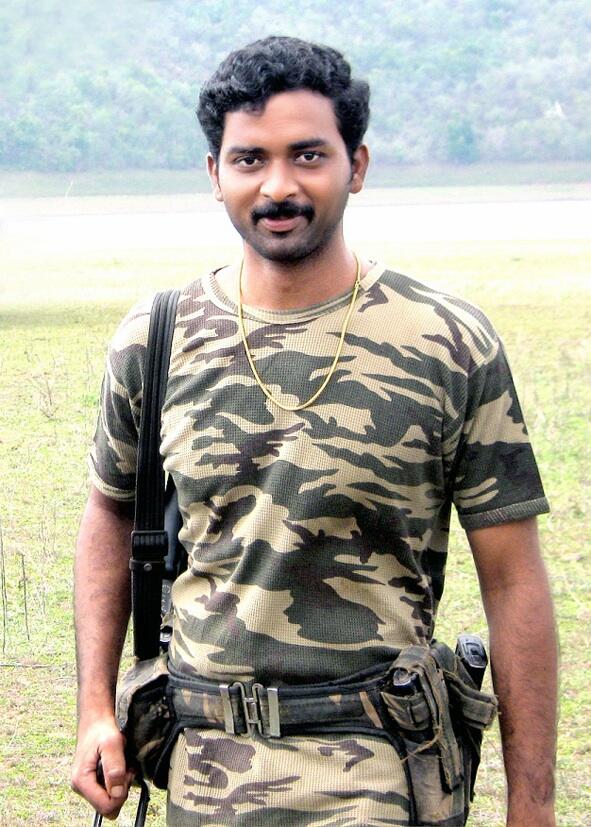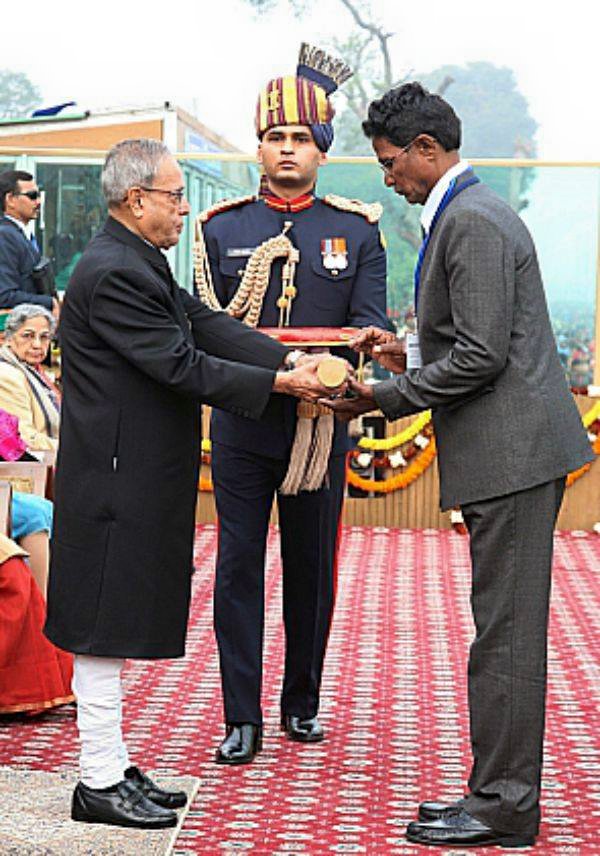This Andhra Commando Singlehandedly Fought Off 200 Naxals to Save His Colleagues!
Posthumously awarded the Ashok Chakra, this braveheart cop is a hero that India should not forget about. He was just 32-years-old when he made the supreme sacrifice to defend his unit.

On January 26, 2014, Karanam Venkata Ramana Naidu, a retired circle officer of the Andhra Pradesh Police, collected the Ashok Chakra, India’s highest peacetime gallantry award, from the then President Pranab Mukherjee on behalf of his slain son K Prasad Babu, a sub-inspector in the State police’s anti-Maoist Greyhounds special operations force.
On April 16, 2013, Babu had heroically saved the lives of four fellow officers and taken out nine high ranking Maoist insurgents before he died on the battlefield. This brave officer from Marturu village in Visakhapatnam district, Andhra Pradesh, was only 32-years-old when he was fatally tortured and killed by Maoist insurgents.
“The [Republic Day] parade began and ended for us when the President handed me the Ashoka Chakra. When I received the prize, Prime Minister Manmohan Singh told me something, but I did not understand. The whole parade passed in a blur. This medal and his memories are all me, and my wife will live for now,” is what a tearful Ramana said to the press after receiving the award on behalf of his martyred son.
These comments reflect both the pain of losing a son in and pride emanating from his gallant heroics. Going through the citation for Prasad Babu’s Ashok Chakra, one cannot help but marvel at the bravery he displayed on that fateful day.
Prasad Babu joined the Andhra Pradesh Police in 2004, and his talents in the field soon earned him a transfer to the elite Greyhounds division, one of the best anti-insurgency forces in India that specialises in anti-Maoist operations and possesses the unique ability to engage in jungle warfare. He was made for the Greyhounds and the events of April 16, 2013, truly reflect this facet.
Based on “credible information about the large-scale movement of Maoists near the Andhra Pradesh-Chhattisgarh border,” five Assault Units of the Greyhounds were deployed.

On the night before April 16, these Greyhound units carefully navigated 40 km of thick jungles marked by landmines and other armed militias. However, as these units approached the core area of their operation by 3:30 a.m. on April 16, they came under heavy fire from 70 Maoist personnel indiscriminately firing their automatic rifles and blasting IEDs.
Despite coming under heavy fire, Prasad Babu and his unit made a beeline towards the Maoists and eliminated nine of their top cadre members while injuring many more.
“Next day the helicopter made five aerial sorties and evacuated the Commandos. However, when 19 commandos along with Shri Prasad Babu were to be picked up in the last sortie, about 60-70 Maoists, along with 50-armed militia, fired on the helicopter and also on the Greyhounds Assault Units,” reads the Ashok Chakra citation.
Of the 19 commandoes yet to be picked up, 14 boarded the helicopter, while the 5 left behind, including Prasad Babu, began firing back in retaliation.
While the helicopter had successfully managed to evacuate 14 commandos, the 5 left behind were now fighting back against a combination of Maoist and other armed militia forces, who were now steadily advancing towards the helipad. “Shri Prasad Babu held the Naxals at bay and fired with grit, determination and with utmost devotion duty putting his life in certain risk,” reads the citation. Once the helicopter took off, the Maoists and other armed militia regrouped and began encircling the five left behind, firing their automatic rifles and throwing grenades towards them.
Fortunately for the encircled five, there was an exit available to the south of where they were trapped. With the number of armed insurgents now reaching approximately 200, Prasad Babu saw no other option but to urge the remaining four commandos to retreat from the south.
Instead of moving along with them, Prasad Babu bravely decided to stand his ground and give cover, holding off 200 insurgents singlehandedly. He was eventually captured, tortured and killed, but saved the lives of not just the 14 who were evacuated, but four of his fellow commandos who managed to reach the safe zone thanks to his heroics. He deserved the Ashok Chakra.

Not much is known about the Greyhounds since their operations are wrapped in secrecy. Raised in 1989 by Indian Police Service officer KS Vyas, who was himself assassinated by Maoists, the Greyhounds have acquired a great deal of success in dealing with Left-Wing Extremism in Andhra Pradesh and Telangana with a strike rate of 98%, according to one senior AP Police officer.
While there were 163 police casualties from 1995 to 2016, the Maoist side has lost 1780 cadre members, 80% of whom were eliminated by the Greyhounds. In other words, the Greyhounds have successfully broken the back of the Maoist insurgency in Andhra Pradesh and Telangana.
Also Read: 10 Times Indian Cops Won Hearts by Going Beyond the Call of Duty
Recruited at an early age, these Greyhounds serve for approximately 15 years, before they are sent back to the regular police force depending on their physical fitness and mental state, according to this report in The Hindu.
On an average a Greyhound officer is rolled back into the general police force by the age of 35, leaving the unit younger, fitter and more agile to deal with insurgents stationed in the jungles. These men are extremely fit, covering on an average 30 km of hilly and forested terrain for an operation, while surviving on meagre rations and dry fruits for four-five days straight.
Prasad Babu was one such Greyhound, who not only showed tremendous awareness, but incredible bravery in allowing his colleagues to retreat from an ambush by giving them cover.
(Edited by Gayatri Mishra)
Like this story? Or have something to share? Write to us: [email protected], or connect with us on Facebook and Twitter.
If you found our stories insightful, informative, or even just enjoyable, we invite you to consider making a voluntary payment to support the work we do at The Better India. Your contribution helps us continue producing quality content that educates, inspires, and drives positive change.
Choose one of the payment options below for your contribution-
By paying for the stories you value, you directly contribute to sustaining our efforts focused on making a difference in the world. Together, let's ensure that impactful stories continue to be told and shared, enriching lives and communities alike.
Thank you for your support. Here are some frequently asked questions you might find helpful to know why you are contributing?


This story made me
-
97
-
121
-
89
-
167














